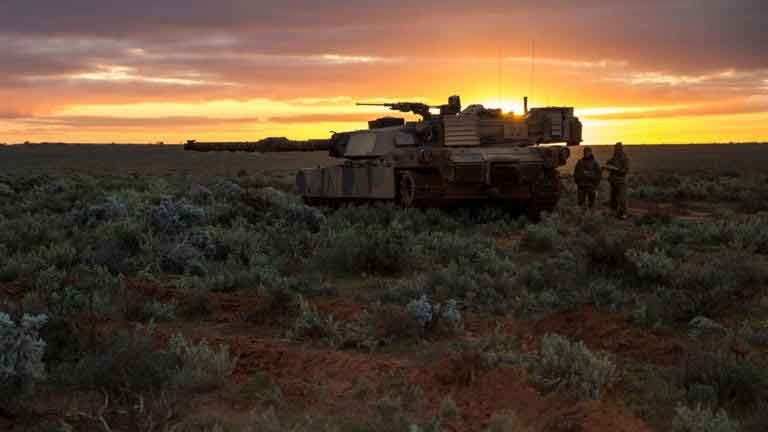Popular Science
Australia wants a laser weapon powerful enough to stop a tank
Story by Kelsey D. Atherton • 6h ago - 3-5-2023
The latter part of the statement is a fairly universal claim across energy weapons development. While laser weapons are power-intensive, they do not need individual missiles, bullets, or shells, the same as what a chemical explosive or kinetic weapon might. Using stored and generated energy, instead of specifically manufactured ammunition pieces, could enable long-term operation on even field-renewable sources, if available. This could also get the shot per weapon use down below the cost of a bullet, though it will take many shots for that to equal the whole cost of developing a laser system.
But getting a laser to punch through the armor of a tank is a distinct and challenging task. A drone susceptible to melting by laser might have a plastic casing a couple millimeters thick. Tank armor, even for older versions of modern tanks, can be at least 600 mm thick steel or composite, and is often thicker. This armor can be enhanced by a range of add-ons, including reactive plating that detonates outward in response to impact by explosive projectiles.
Defeating tank armor with lasers means finding a way to not just hold a beam of light against the tank, but to ensure that the beam is powerful and long-lasting enough to get the job done.
“One problem faced by laser weapons is the huge amount of power required to destroy useful targets such as missiles. To destroy something of this size requires lasers with hundreds of kilowatts or even megawatts of power. And these devices are only around 20% efficient, so we would require five times as much power to run the device itself,” wrote Sean O'Byrne, an engineering professor at UNSW Canberra and UNSW Sydney, in a piece explaining the promise and peril of anti-tank lasers.
O’Byrne continued: “We are well into megawatt territory here — that's the kind of power consumed by a small town. For this reason, even portable directed energy devices are very large. (It's only recently that the US has been able to make a relatively small 50kW laser compact enough to fit on an armoured vehicle, although devices operating at powers up to 300kW have been developed.)”
April’s announcement of a modest sum to develop a domestic laser weapon capability in Australia is a starting point for eventually getting to the scale of lasers powerful enough to melt tanks. Should the feat be accomplished, Australia will find itself with an energy-hunger tool, but one that can defeat hostile armor for as long as it is charged to do so.
Articles may contain affiliate links which enable us to share in the revenue of any purchases made.
An armored vehicle in Australia in 2016.
© Mandaline Hatch / US Marine Corps.
Australia wants a laser weapon powerful enough to stop a tank
Story by Kelsey D. Atherton • 6h ago - 3-5-2023
The latter part of the statement is a fairly universal claim across energy weapons development. While laser weapons are power-intensive, they do not need individual missiles, bullets, or shells, the same as what a chemical explosive or kinetic weapon might. Using stored and generated energy, instead of specifically manufactured ammunition pieces, could enable long-term operation on even field-renewable sources, if available. This could also get the shot per weapon use down below the cost of a bullet, though it will take many shots for that to equal the whole cost of developing a laser system.
But getting a laser to punch through the armor of a tank is a distinct and challenging task. A drone susceptible to melting by laser might have a plastic casing a couple millimeters thick. Tank armor, even for older versions of modern tanks, can be at least 600 mm thick steel or composite, and is often thicker. This armor can be enhanced by a range of add-ons, including reactive plating that detonates outward in response to impact by explosive projectiles.
Defeating tank armor with lasers means finding a way to not just hold a beam of light against the tank, but to ensure that the beam is powerful and long-lasting enough to get the job done.
“One problem faced by laser weapons is the huge amount of power required to destroy useful targets such as missiles. To destroy something of this size requires lasers with hundreds of kilowatts or even megawatts of power. And these devices are only around 20% efficient, so we would require five times as much power to run the device itself,” wrote Sean O'Byrne, an engineering professor at UNSW Canberra and UNSW Sydney, in a piece explaining the promise and peril of anti-tank lasers.
O’Byrne continued: “We are well into megawatt territory here — that's the kind of power consumed by a small town. For this reason, even portable directed energy devices are very large. (It's only recently that the US has been able to make a relatively small 50kW laser compact enough to fit on an armoured vehicle, although devices operating at powers up to 300kW have been developed.)”
April’s announcement of a modest sum to develop a domestic laser weapon capability in Australia is a starting point for eventually getting to the scale of lasers powerful enough to melt tanks. Should the feat be accomplished, Australia will find itself with an energy-hunger tool, but one that can defeat hostile armor for as long as it is charged to do so.
Articles may contain affiliate links which enable us to share in the revenue of any purchases made.
An armored vehicle in Australia in 2016.
© Mandaline Hatch / US Marine Corps.
3 yr. ago


